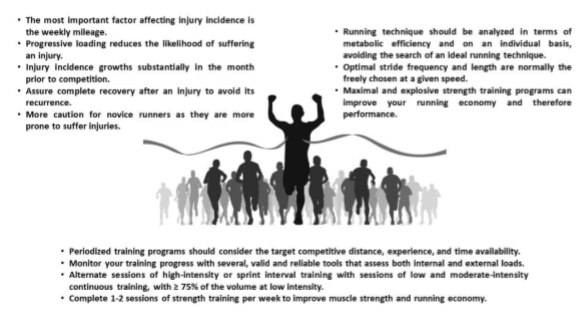Factors Affecting Training And Physical Performance In Recreational Endurance Runners
INTRODUCTION
Recreational running is a simple and accessible sport attracting millions of participants world-wide. Despite the great popularity, there is no consensus on best training practices for improved performance. There are, however, a plethora of anecdotal guidelines without robust scientific support. The authors’ goal in the article, Factors Affecting Training and Physical Performance in Recreational Endurance Runners, is to present a selection of scientific evidence regarding the best training practices and provide a starting point for further studies. The study focuses on key aspects of training, such as periodization, training methods and monitoring, performance prediction, running technique, and prevention and management of injuries associated with endurance running. Below is the summary of the authors’ recommendations regarding various aspects of training.
Recommendations for Training Characteristics of Recreational Endurance Runners
Running Training Methods
- A combination of methods, including one to two high-intensity interval training (HIIT) sessions per week plus more sessions with moderate- and low intensity continuous sub-maximal running, is generally recommended to improve performance in recreational runners in a healthy manner.
Strength Training (ST)
- Although there is a lack of knowledge regarding the optimal volume and intensity of ST for endurance running performance, the inclusion of ST in the training regime of recreational runners might be recommended, even for marathoners.
Training Intensity Distribution
- The pyramidal and polarized training models might be the most recommended forms of training intensity distribution for recreational runners, with different considerations depending on competitive distance, time available to train, and time of the season.
- Pyramidal Training Model: Ramp distance and/or speed up and then back down in a “pyramid-like” style.
- Polarized Training Model: Focus on different running intensities (low or high intensity) at each training session.
Training Periodization
- Periodization is the altering of frequency, intensity, and volume of training sessions over a period of time to help runners arrive at peak fitness on race day.
- Linear Periodization: This training method uses four phases, comprised of a base phase, strength phase, anaerobic phase, and racing phase. This training method has proven successful for runners competing in short or moderate distances less than 21 Kilometers.
- Reverse Linear Periodization: Opposite of linear periodization, this training method focuses on shorter, more intense workouts which gradually transition into longer, less intense workouts closer to race-day. This method is good for marathon training, novice runners, and for strength training.
- Block Periodization: This method separates the volume and intensity elements of the training period, possibly in separate weeks. This training method has proven to be effective for short or moderate distance runners.
Training Monitoring
- Monitoring is used by the coach and runner to maximize training performance. Incremental field-testing for identification of maximum aerobic speed (MAS) could be considered the most practical, as MAS integrates both VO2max and running economy (RE) into a single parameter. RE is the energetic cost of running at a given speed.
Performance Predictions
- The best way to predict recreational runners’ racing times may be to record individual performances over shorter distances and to conduct assessments close to the race pace. For instance, complementing actual shorter distance training results with the expected steady state pace during the event could predict running performance.
Factors Associated with Running-Related Injuries
Running Technique (RT)
- Contrary to common belief, the search for a “one-size-fits-all” RT is not accompanied by improvement in performance or RE. In this regard, the recommendation of a global RT is not effective nor advisable.
- The strongest direct links with RE are running biomechanics during the contact phase, particularly those during propulsion or push-off. Thus, a protocol for increasing the preferred stride frequency by 10% while reducing the preferred stride length by 10% decreases the peak hip adduction angle and vertical loading rates; parameters associated with RRIs.
- There is no evidence that forefoot strike vs. rearfoot strike is advantageous for improved running performance.
Risk Factors
- The most important intrinsic risk factor for endurance running injury is the existence of a previous injury, indicating that special attention should be taken to avoid recurrent injuries in endurance runners. Using a gradual increase in training load in the first weeks of training after recovery is paramount.
- A high weekly running mileage is another risk factor among recreational endurance runners. For this reason, training for long distance races (e.g., ultra-endurance competitions) is also a risk factor for incurring running-related injuries
- If training is balanced according to the characteristics and experience of the athlete while avoiding both overuse and underconditioning, injury risk is expected to be controlled even in the case of conducting high volumes of training.
Running shoes
- Current evidence does not support the claim that increased shock absorption reduces the likelihood of injury.
Diet
- The available evidence is insufficient to determine whether total energy intake per day or macronutrient and micronutrient proportions in the diet are associated with the prevalence of injury in endurance runners.
- The International Olympic Committee indicates that only two supplements are sufficiently supported by science: Vitamin D to treat nutrient deficiencies that can lead to bone injuries and creatine to maintain lean mass during periods of immobilization after injury.
Conclusions and Physical Therapy First Implications
Preparations should be made for long-distance events, such as marathons and ultra-endurance races, to balance conditioning without increasing the risk of overuse injuries. Runners with one or more risk factors for endurance running injuries should be aware of the first signs of injury and should immediately change their training practices or cease training to elude other risk factors. At Physical Therapy First, we keep these recommendations in mind and focus on prevention of injuries in addition to treatment of RRIs to keep you healthy for your next race.

Reference:
Boullosa, D., Esteve-Lanao, J., Casado, A., Peyre-Tartaruga, Leonardo., Gomes da Rosa, Rodrigo., Del Coso, Juan (2020). Factors Affecting Training and Physical Performance in Recreational Endurance Runners. MDPI Sports: 8, 35.
